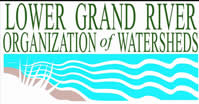Lower Grand Watershed Interactive Tool (WIT) - Stormwater

FYI on Local Water Issues
In a natural setting when it rains the water is absorbed into the soil and filtered before reaching any main bodies of water. Today we have streets, parking lots, and buildings these are all considered impervious surfaces, because the water cannot be absorbed through the surface into ground. Rain that falls onto these surfaces gathers pollutants such as oils, gas, anti-freeze, tar, and salt. This now polluted water is flushed through storm drains or ditches into streams, river and lakes without being filtered. This is a major health concern for humans, and it also affects the aquatic species in the stream.
Other forms of pollution associated with storm water are sedimentation and thermal pollution:
- Sedimentation pollution occurs when the storm water is prevented from filtering through the soil. The storm water is then funneled directly into the water body, which changes the hydrology. This process causes erosion on streambanks. Sedimentation threatens aquatic species, riparian landowners, and water quality. Sedimentation is very costly to repair.
- Thermal pollution occurs when the storm water runs across warm/hot surfaces such as roads, rooftops, and sidewalks. The storm water warms up considerably before reaching a water body. This event causes the water temperature to change in river, stream, and lakes; which in turn threatens aquatic species by limiting the oxygen supply in the water.
For more information on stormwater, consult the following resources:
- Kent County Stormwater Handbook
- Kent County Stormwater Model Ordinance
- Storm Water Resource Locator
- The Stormwater Journal - excellent resource of information on the newest storm water practices
- The Stormwater Manager's Resource Center
- EPA Stormwater
- An Internet Guide to Financing Stormwater Management
- The Natural Resources Defense Council Stormwater Strategies
- International Stormwater BMP Database
- West Michigan Environmental Action Council (WMEAC) Stormwater Education
It is a common misconception that storm drains lead to the sewer system. However, this is not the case. Storm drains send water directly into streams, rivers, and lakes without treatment. This causes problems when residents pour gas, oil, paint, and soapy water down a storm drain. These pollutants go straight into a water body and destroy fish and other aquatic species, it also causes a real health problem for humans. Many environmental groups and communities are organizing storm drain stenciling days to control the illegal pouring of pollutants down a storm drain.
Storm drains are not all bad! They help to control flooding, and without them stagnant water would cover our streets and sidewalks which would be a breeding ground for mosquitoes.
For more information on storm drains, consult the following resources:
